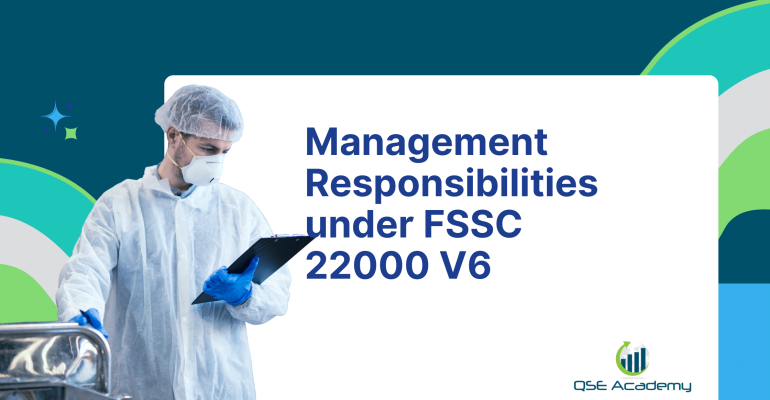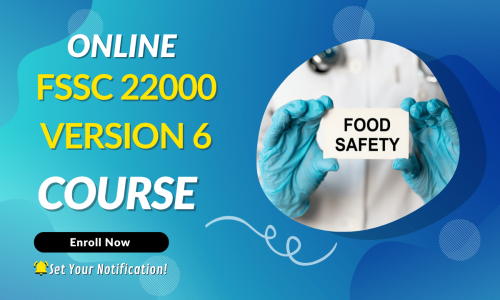Management Responsibilities under FSSC 22000 V6
Last Updated on October 13, 2025 by Hafsa J.
Management Responsibilities under FSSC 22000 V6
Let’s be honest—when it comes to food safety certifications, a lot of managers think, “That’s QA’s job.”
But here’s the truth I’ve seen over and over again: if leadership isn’t actively involved, the food safety system falls apart the moment things get stressful.
Under FSSC 22000 Version 6, management isn’t just expected to approve budgets or sign policies. The standard wants leadership to step up—to guide the culture, own the risks, and drive real accountability across the business.
And if that sounds overwhelming, don’t worry—you’re not alone. I’ve worked with plenty of companies (from family-run producers to international brands) who weren’t sure what “management responsibility” really looked like in practice.
That’s exactly what this article is here to clarify. You’ll learn:
-
What FSSC 22000 V6 actually expects from top management,
-
How to demonstrate leadership during audits, and
-
What real-world strategies help leaders drive compliance without adding unnecessary complexity.
So, if you’re leading a food business—or supporting those who do—this guide will help you understand your role, avoid the most common pitfalls, and build a food safety culture that’s both effective and audit-ready.
Let’s dive in.
What’s Changed in FSSC 22000 Version 6 for Management?
Here’s what I’ve noticed working with leadership teams recently—many assume that the new version of the standard only affects operational procedures or documentation. But that’s not the case. FSSC 22000 Version 6 puts more pressure on leadership than ever before.
So what’s actually new?
1. Food Safety Culture Isn’t Just a Buzzword Anymore
The concept of food safety culture has been floating around for years, but now it’s officially baked into the standard.
Leadership is expected to actively promote, support, and evaluate food safety culture—not just approve a policy and walk away.
What this means in real life:
If your team isn’t hearing about food safety from upper management, if concerns are ignored, or if training feels like a checkbox activity, that’s a problem.
2. Clearer Accountability
Top management now needs to assign and document specific roles and responsibilities related to food safety.
This includes identifying who’s responsible for communication with regulators, who leads the food safety team, and how decisions are made when something goes wrong.
In one project I led, we found three different managers thought someone else was in charge of recalls. Not great during an audit—or worse, a real emergency.
3. New Requirement: Communication with Authorities
This one’s a big shift.
FSSC 22000 V6 requires a formal plan for how your organization will communicate with regulatory authorities in the event of a food safety incident. That includes who makes the call, what’s said, and how fast it happens.
And yes, auditors are asking to see this during the audit—not just in your crisis management SOP, but in practice.
4. More Emphasis on Management Review
The standard is pushing for deeper, more strategic management reviews—not just reviewing last quarter’s KPIs.
Think: Are we improving? Are risks changing? What do we need to do better?
Leadership Commitment: More Than Just a Signature
Let’s be real—signing off on a food safety policy once a year doesn’t cut it anymore.
FSSC 22000 Version 6 expects management to be involved, visible, and engaged in food safety on a day-to-day basis. This isn’t symbolic support. It’s about leadership setting the tone from the top.
What Does “Leadership Commitment” Really Mean?
In practice, it looks like this:
-
Showing up. Attending food safety meetings. Asking questions during internal audits. Participating in reviews instead of delegating them.
-
Backing your team. Allocating enough resources—people, time, and tools—to actually implement and maintain the food safety system.
-
Driving improvement. Challenging the status quo. Encouraging staff to speak up when they see risks or near-misses.
-
Owning the outcomes. Whether there’s a non-conformance, a recall, or a new regulation—management needs to lead the response.
Real-World Example
I worked with a seafood processor where the QA manager handled everything—HACCP, audits, complaints, you name it. Leadership was supportive “in theory,” but never involved directly.
Then came an unannounced audit. The certifying body asked the plant manager about the site’s top three food safety risks—and he couldn’t answer. That moment set off a cascade of findings and a lot of uncomfortable conversations.
We turned it around by creating a “leadership engagement plan” that included monthly walk-throughs, report reviews, and a few minutes dedicated to food safety in every operations meeting. Six months later, they passed their follow-up audit with no major findings.
Why This Matters
Auditors can tell the difference between a leadership team that knows the system and one that signs off on it.
More importantly, so can your team. When leaders take food safety seriously, everyone else does too.
Defining Roles, Responsibilities, and Authorities
Here’s something I tell every leadership team during implementation:
If no one owns it, it won’t happen.
FSSC 22000 Version 6 makes it crystal clear—management must assign, document, and communicate who’s responsible for what within the food safety management system (FSMS).
And no, this isn’t about creating an org chart just for show. It’s about ensuring every critical function in your FSMS has clear accountability behind it.
What You’re Expected to Define
-
Who leads the food safety team
This isn’t just a title—this person needs the authority, training, and time to actually lead. -
Who approves and controls food safety documents
It should be clear who signs off on procedures, updates PRPs, and maintains version control. -
Who handles regulatory communication and emergencies
This one’s new under V6. You need a defined chain of command for crisis communication—with backups in case the lead is unavailable. -
Who monitors and evaluates FSMS performance
Assign clear roles for collecting data, analyzing trends, and preparing inputs for the management review.
Common Gaps I See (And How to Avoid Them)
-
Ambiguity in job descriptions
“Supports food safety” isn’t enough. Be specific—what are they supporting, and how? -
No backup personnel
If your food safety team leader is off for two weeks, what happens? Build continuity into your assignments. -
Disconnect between documented roles and reality
If the procedure says one thing and people do another, you’ve got a problem.
Make sure your system reflects how things actually work—or fix the process so it matches what’s written.
Real Example
At a mid-sized bakery I worked with, everyone assumed the QA manager would handle recalls. But there was no formal designation, no backup, and no cross-training. During a mock recall, the QA manager was on vacation—and no one knew what to do. That exercise led to a complete restructure of roles, plus hands-on training for key staff.
The result? A confident, responsive team—and a clean audit report a few months later.
Promoting and Supporting a Food Safety Culture
Let’s be honest—“food safety culture” is one of those terms that sounds great in theory but often gets lost in practice.
FSSC 22000 Version 6 changes that. It doesn’t just recommend culture—it expects you to build, support, and prove that food safety is part of your company’s everyday mindset.
And no, posting a “Safety First” sign in the break room doesn’t count.
What Does the Standard Really Mean by “Culture”?
It’s about how people think, talk, and act when it comes to food safety—especially when no one’s watching.
According to FSSC 22000 V6, top management is expected to:
-
Lead by example. If leadership cuts corners or ignores safety issues, staff will follow suit.
-
Encourage open communication. Employees need to feel safe reporting concerns—even if they’re small.
-
Recognize and reward good behavior. A simple shoutout for following proper sanitation can go a long way.
-
Support continuous learning. Culture doesn’t grow without training, refreshers, and honest discussions.
How Leadership Can Actually Build Culture
-
Start every ops meeting with a food safety check-in.
-
Share lessons learned from audits or near-misses (transparently).
-
Invite employees to contribute ideas for improving food safety practices.
-
Make food safety a standing item on performance reviews—not just for QA staff, but for everyone.
In one facility I worked with, the plant manager started eating lunch in the breakroom twice a week just to listen to the floor staff. That small act built trust, surfaced real risks, and gave leadership visibility they didn’t have before.
What Auditors Want to See
Auditors will ask:
-
How do you promote food safety culture?
-
How do you know it’s working?
-
Can you give examples of improvements or team involvement?
So you’ll need evidence like:
-
Meeting minutes
-
Internal surveys or feedback tools
-
Documented training and refresher sessions
-
Actions taken as a result of staff input
Management Review and Strategic Oversight
Now that we’ve covered leadership commitment and culture, let’s talk about something that often gets rushed or treated like a checkbox: the management review.
Under FSSC 22000 Version 6, this isn’t just a once-a-year meeting to look at KPIs. It’s your chance to step back, assess the big picture, and guide the strategic direction of your food safety system.
And if done right, it’s one of the most valuable tools leadership has.
What the Standard Requires
FSSC 22000 expects management to regularly review the effectiveness and continual improvement of the food safety management system (FSMS). That means looking at:
-
Audit results (internal and external)
-
Nonconformities and corrective actions
-
Performance against food safety objectives
-
Emerging risks or changes in regulations
-
Supplier performance
-
Customer feedback and complaints
-
Progress on actions from the previous review
What This Looks Like in Real Life
Don’t just read off a spreadsheet. Use the review meeting to ask questions like:
-
Are we improving, or just maintaining?
-
What’s changed in our operations or supply chain since last quarter?
-
Are our food safety objectives still aligned with business goals?
At one frozen food company I supported, we restructured their management reviews to include monthly mini-reviews with focused themes (e.g., just suppliers, just nonconformities). This made the annual review smoother—and more actionable.
Why It Matters
Auditors want to see that management isn’t just reviewing data but making decisions based on that data. They’ll look for meeting minutes, action items, and evidence that review outcomes led to real improvements.
And from a business standpoint, this is where food safety and profitability intersect. A strong management review helps identify risks before they become costly problems.
Avoid These Common Pitfalls
-
Reviewing performance too infrequently
-
Skipping key inputs like emerging risks or regulatory changes
-
Failing to follow up on action items from previous reviews
-
Letting one person (usually QA) run the entire show without leadership input
Communication with Authorities: A New (and Crucial) Requirement
One of the most significant additions in FSSC 22000 Version 6 is the requirement for documented procedures on communicating with regulatory authorities.
And let me tell you—it’s not something you want to overlook.
In a real emergency—like a contamination event or a product recall—the last thing you want is internal confusion about who picks up the phone, what they’re supposed to say, or how quickly action needs to happen.
What the Standard Now Requires
You need to have a formal, tested plan that outlines:
-
Who is responsible for notifying authorities in the event of a food safety issue
-
What information needs to be communicated (e.g., affected products, corrective actions, risk assessments)
-
How quickly authorities will be contacted once a risk is confirmed
-
How the communication is documented and shared internally
This is no longer just a best practice—it’s a required part of your FSMS.
What Good Communication Planning Looks Like
-
Assign primary and backup personnel with clear authority to act
-
Include local and national contact information in the plan
-
Test the process through recall simulations or emergency drills
-
Make sure everyone involved is trained—and knows exactly what to do
One company I worked with had the food safety manager listed as the sole point of contact. But when he was on vacation during a mock recall, the team hesitated, delays followed, and confidence took a hit. That drill led to a rewritten plan, full team training, and much better preparedness.
Why It Matters for Audits—and Reality
Auditors will want to see your documented plan, but they’ll also ask questions like:
-
Has this plan ever been tested?
-
Who made the last regulatory contact, and how was it handled?
-
How does your team stay up to date with changes in reporting requirements?
Even more important—if a real issue arises, clear and timely communication could be the difference between a manageable recall and a public crisis.
Pro Tips and Insider Insights for Leadership Success in FSSC 22000 V6
These are the things I share in boardrooms, during gap assessments, and after audits when leadership teams ask, “What should we really be doing differently?” Here’s what works in the real world—not just on paper.
Pro Tip #1: Make Food Safety a Standing Agenda Item
Don’t wait for annual reviews. Add food safety to your regular leadership meeting agenda—even if it’s just a five-minute check-in.
It keeps the system alive and shows your team it’s a consistent priority.
Pro Tip #2: Create a One-Page FSMS Dashboard
Executives don’t need to see every audit record. But a simple, visual snapshot of KPIs, risks, audit results, and open actions? That keeps leadership informed and engaged without getting overwhelmed.
One of my clients hangs this dashboard in the team briefing room. It’s updated monthly, and the staff actually ask about it—it’s become part of the culture.
Pro Tip #3: Cross-Train for Key Roles
Don’t rely on just one person to manage food safety communication or lead audits. Train backups, document responsibilities, and simulate staff absences so you’re not caught off guard.
Pro Tip #4: Normalize Speaking Up
Make it easy for employees to report concerns without fear of blame. One site I supported created a simple anonymous suggestion box—and got five valuable improvement ideas in the first week.
Pro Tip #5: Document Leadership Involvement
When you attend an audit, ask questions, sign off on FSMS reviews, or walk the floor—document it. These little signs of engagement make a big impression during audits.
Common Mistakes to Avoid and Leadership FAQs
Even the most committed leadership teams can run into trouble during implementation or audits—not because they don’t care, but because some responsibilities get lost in translation. Let’s walk through a few of the pitfalls I see most often, and then answer the questions I hear from food industry leaders all the time.
Common Mistakes That Undermine Management’s Role
1. Delegating food safety too far down the chain
It’s tempting to hand everything over to QA or operations—but the standard is clear: top management is accountable. Support your team, but stay involved.
2. Treating management review as an annual box to check
If you’re only reviewing the FSMS once a year—and doing it passively—you’re missing critical trends and opportunities for improvement.
3. Vague or outdated job roles
I often see documented responsibilities that haven’t been updated in years. If someone’s name is still on the food safety plan but they left the company two years ago, that’s a problem.
4. Skipping food safety culture efforts
Assuming “everyone knows safety is important” isn’t enough. The standard now expects clear leadership actions and evidence that culture is being built—intentionally.
5. Unclear escalation during food safety incidents
When something goes wrong, who calls the regulator? Who pulls product? If that chain of command isn’t documented, trained, and tested—it can slow you down when speed matters most.
Frequently Asked Questions
Q1: Does leadership really need to attend audits or food safety meetings?
Yes—and not just for show. Auditors expect to see active involvement. Even a 30-minute check-in during an internal audit shows commitment.
Q2: How do we show evidence of promoting food safety culture?
Document team briefings, training sessions, surveys, leadership walk-throughs, and feedback programs. Anything that reflects real engagement with the workforce.
Q3: What’s the risk of not assigning backups for FSMS roles?
Besides nonconformities during audits, you risk system failure if someone’s out during a recall or audit. Build redundancy into your FSMS like you would any critical business system.
Leadership isn’t about knowing every technical detail. It’s about being visible, responsible, and responsive—and making food safety part of how your organization thinks, plans, and performs.
What Leadership Really Means in FSSC 22000 V6
If there’s one thing I hope you take away from this—it’s this:
FSSC 22000 Version 6 doesn’t just want leadership on the sidelines. It expects you to be in the game.
From setting direction and allocating resources, to supporting your team and driving culture, the role of management under this standard is both strategic and hands-on. And when done well, it doesn’t just satisfy auditors—it strengthens your business.
We’ve covered the key expectations, from promoting food safety culture and assigning clear roles, to leading management reviews and preparing for regulatory communication. You now know what leadership needs to do, not just say.
In my experience, companies that fully embrace these responsibilities build stronger teams, reduce audit stress, and become more resilient over time.
What You Should Do Next
If you’re a senior leader, site manager, or food safety coordinator wondering how to move forward—here’s a simple roadmap:
-
Need clarity on your responsibilities?
Download our free “FSSC 22000 Leadership Roles Checklist”—a one-page reference to guide your efforts. -
Want to make sure your FSMS is audit-ready?
Book a strategy call with one of our consultants. We’ll walk through your system and pinpoint gaps before they become findings. -
Building a food safety culture from the top down?
We offer tailored leadership coaching and team alignment sessions to help you make food safety part of your day-to-day decisions.
Food safety starts with leadership. And with the right focus, tools, and support, you can meet the expectations of FSSC 22000 V6—and lead your organization with clarity and confidence.
Ready to take the next step? We’re here to help.
Whether it’s ISO 9001, ISO 22000, or the cosmetics-focused ISO 22716, I’ve spent my career I’m not here to call myself an expert—I prefer “enthusiast” because I truly love what I do. When I’m not writing about standards, you’ll probably find me playing Piano 🎹, connecting with people, or diving into my next big project💫. I’m an engineer specialized in the food and agricultural industry
make ISO standards less intimidating and more approachable for everyone.
turning complex jargon into clear, actionable steps that businesses can actually use.
There’s something incredibly rewarding about helping people navigate food safety and quality management systems
in a way that feels simple, practical, and even enjoyable.
I have a Master’s in QHSE management and over 12 years of experience as a Quality Manager
I’ve helped more than 15 companies implement ISO 9001, ISO 22000, ISO 22716, GMP, and other standards
My clients include food producers, cosmetics manufacturers, laboratories, and service companies
I believe quality systems should be simple, useful, and efficient.

















